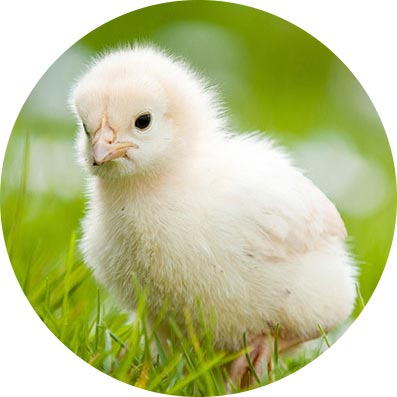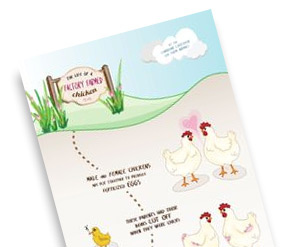Every year 750 million chickens are raised for meat in Canada, the most of any species.
Chickens are intensively reared in groups of 5,000 to 65,000 birds in large sheds.
The birds can endure up to 20 hours of artificial light every 24 hours.
Poor air and litter quality causes respiratory infections.
Factory farms were designed for one thing: putting out the most product in the least time
Factory "farms" are actually fast-paced, mechanized facilities. This stressful environment purposefully leaves no room for human beings to act on their innate compassion.

Today’s farms force birds to gain weight 6 times faster than normal. Imagine a human 5-month old weighing 60 lb
Genetic selection and antibiotics are used to induce rapid growth, which causes crippling skeletal and heart disorders. As a result, the birds’ fragile bones can't support their body weight. They are often injured before and during transport.
1988
1.36 kg in in 84 days
2015
1.75 kg in 33 days
(6X natural growth rate)
Farmers can be penalized if their birds don't meet weight requirements.
Each province in Canada has strict Supply Management regulations. Farms with more than the provincially-set number of birds (often 100) must buy "quota", which strictly defines what farms may produce. Farms buy broiler chicks from hatcheries (often owned by kill plants), and contract with the kill plant to buy back and transport the birds at specified weights.
These still immature chicks are so obese they can't even walk properly
Credit: Knowles T, Kestin S, Haslam S, Brown S, Green L, Butterworth A, Pope S, Pfeiffer D, Nicol C. 6 February 2008
Chickens on modern farms can't engage in many basic behaviors like perching, dust-bathing, or establishing a social order.
Meat chickens live for only about a month before being killed
The meat you see in grocery stores comes from immature chicks equivalent to 5 months old in human years. They don’t even have full feathers yet. They are living beings, yet we grant them none of life’s joys: a mother’s love, playing, or even seeing the sun.

Meat Chickens live about 1 month
Broiler breeder birds live about 1 year
Natural life of chickens: 15-20 YEARS
How long do wild birds live?
Many birds live for years in the wild, some into ripe old age, even with predators and natural adversity. Wouldn't you trade a year’s life in nightmarish confinement for even a month to truly experience life? What broiler birds have is not life.
The plight of broiler breeder birds
Constant Hunger
Breeders suffer nutritional deficiencies and constant hunger due to feed restriction to curb growth. Male breeders have a plastic rod inserted painfully into the nasal cavity to prevent them from accessing hens’ food.
Mutilation Without Anesthetic
To reduce aggression from stress, breeders have their toes and beaks cut off. Males have their combs and leg spurs painfully cut off. A better solution is to improve the living conditions.
The greatest thing you can do is eat less chicken
Reducing consumption reduces suffering! It also happens to be great for your overall health and for the environment.
Industry changes we will push for:
Let's move birds into a richer environment where they can nest, perch, forage, and engage in other natural behaviors.
More pages




